Last year an estimated 1.2 million foreign and 4.4 million domestic tourists visited Punjab, one of India’s most prosperous, vibrant and hospitable states
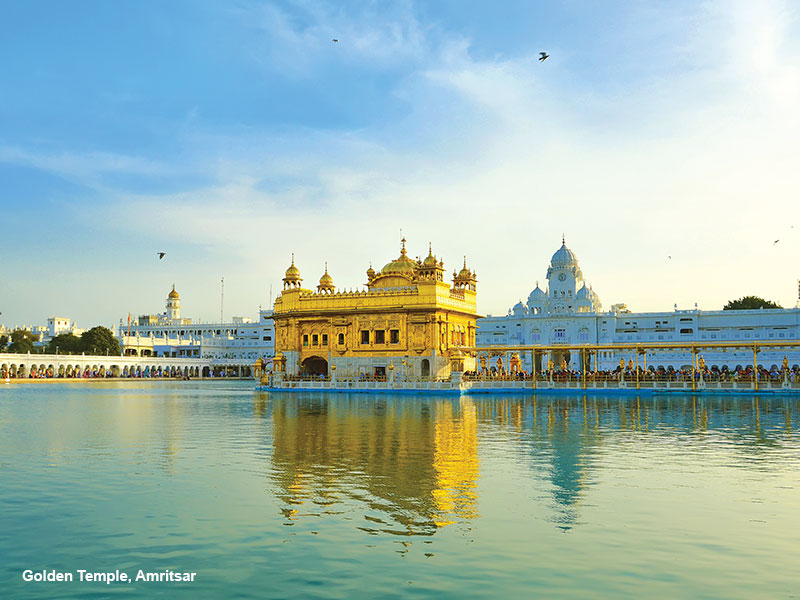
The great Punjabi diaspora which has scattered the people of this land of five rivers to all parts of the globe — USA, Britain, East Africa, Canada and the Far East — has transformed Punjab (pop. 28 million) into a vibrant tourism destination. Large numbers of industrious Punjabis who have made good abroad, are increasingly visiting the land of their fathers and inspiring friends and relations abroad to do the same.
Last year an estimated 1.2 million foreign and 4.4 million domestic tourists visited one of India’s most prosperous states measured by per capita income (Rs.1.5 lakh per year). Renowned for yellow mustard fields set against the backdrop of misty blue mountains, this granary state of India which contributes 17.4 and 11.3 percent of India’s wheat and rice production, also offers religious sites steeped in history. Moreover this northern state was for long the seat of royalty, the legacy of which is preserved in its splendid palaces. There are museums galore here and places of religious interest such as the world-renowned Golden Temple in Amritsar, patinated with 24-carat gold leaf.
For lovers of the great outdoors as well as wildlife enthusiasts there are tours of several sanctuaries, habitats of rare migratory birds. And because the state borders Pakistan, it offers several posts from which a visitor can take a peep into wide swathes which were once part of India.
 Chandigarh
Chandigarh
Punjab and India’s most well-planned state capital has a cosmopolitan character. Designed by renowned French architect Le Corbusier in the 1950s, it is a splendid mélange of green parks, landscaped gardens, azure lakes, glitzy shopping malls, designer homes and tony eateries. The city’s unique Rock Garden — designed by acclaimed landscape artist Nek Chand — attracts hordes of tourists year round. Lake Sukhna with its numerous entertainment options including rowing and boating, is a favourite rendezvous. It has also been the venue of several national and international rowing championships.
Chandigarh’s Rose Garden — a riot of psychedelic roses from all parts of the world — is also a sight for sore eyes. Built on a sprawling 30-acre plot in the heart of town, it contains a massive greenhouse that boasts of over 1600 different rose species. Chandigarh also buzzes with shopping malls which offer everything from designer clothing to fancy footwear, handbags, handicrafts and consumer durables. The city’s street food covers all types of cuisines — from north Indian to Greek and Japanese — all with a Punjabi flavour.
Accommodation: Hotel Sunbeam (Rs.8,084 per night), The Lalit Chandigarh (Rs.8,024), James Hotel (Rs.3,497), Lemon Tree (Rs.4,365), Hotel Emerald (Rs.2,955), Treebo Trip (Rs.1,656), Hotel Mountview (Rs.4,323).
Amritsar
Amritsar (‘holy pool of nectar’) derives its name from the famous pool which surrounds the Golden Temple. Once pre-eminent city of the Orient during the reign of Maharaja Ranjit Singh (1770-1839), Amritsar (pop. 2.80 million) has successfully retained its spiritual and historical heritage while transforming into a cosmopolitan city. Today, it is an important industrial hub which hosts the country’s second largest milk processing plant and flourishing textile, electronic goods, auto parts and carpet weaving industries.
The Golden Temple. Amritsar’s most famous landmark is this widely revered shrine of Sikh community. The idea of constructing this gleaming architectural splendour was incubated in 1579 by Guru Ramdas — the fourth of the nine gurus of the Sikh community — who resolved to build a temple on land gifted to him by the Mughal Emperor Akbar (1542-1605). The Pool of Nectar was first excavated and a decade later in 1588, a temple was raised by the sixth Sikh guru Arjun Dev to enshrine the Guru Granth Sahib, the sacred book of the community. The temple’s golden dome, coated with copper and pure gold leaf and its sky-piercing turrets have earned it its famous descriptive.
The sacred tank is contained by a marble boundary. Through the splendorous Darshni Deorhi gateway pilgrims move with utmost devotion across a marble causeway to enter the holy sanctorum. After darshan, and on receiving karah parsad (holy offering), most of them proceed to the langar (community kitchen) to eat a free meal cooked within the temple premises.
The Sikh Museum in the clock tower of the temple comprises a gallery of paintings depicting the history of Sikh heroes and martyrs.
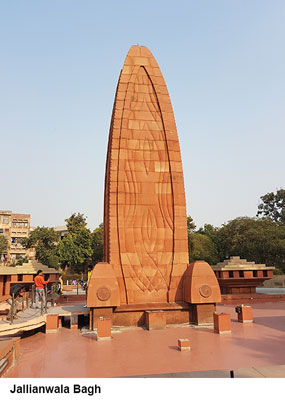 Jallianwala Bagh memorial. This historic memorial built in the shape of an eternal flame of liberty is situated adjacent to the Golden Temple. The venue of the infamous massacre of over 2,000 people including women and children on April 13, 1919, by British soldiers commanded by General Dyer, Jallianwala Bagh has attained the status of a martyrs’ pilgrimage site in the popular imagination. An estimated 2,020 citizens who had gathered for a peaceful protest meeting were mercilessly mowed down by machine guns. The few who jumped into a nearby well to escape the volley of bullets drowned. Jallianwala’s bullet-scarred walls now enclose a memorial symbolising the eternal flame dedicated to these martyrs. Every Baisakhi day (April 13), the nation pays homage to Dyer’s victims. Over half a century later in a belated gesture of atonement Queen Elizabeth II and her husband laid a wreath at the memorial on October 14, 1997 but stopped short of rendering a public apology.
Jallianwala Bagh memorial. This historic memorial built in the shape of an eternal flame of liberty is situated adjacent to the Golden Temple. The venue of the infamous massacre of over 2,000 people including women and children on April 13, 1919, by British soldiers commanded by General Dyer, Jallianwala Bagh has attained the status of a martyrs’ pilgrimage site in the popular imagination. An estimated 2,020 citizens who had gathered for a peaceful protest meeting were mercilessly mowed down by machine guns. The few who jumped into a nearby well to escape the volley of bullets drowned. Jallianwala’s bullet-scarred walls now enclose a memorial symbolising the eternal flame dedicated to these martyrs. Every Baisakhi day (April 13), the nation pays homage to Dyer’s victims. Over half a century later in a belated gesture of atonement Queen Elizabeth II and her husband laid a wreath at the memorial on October 14, 1997 but stopped short of rendering a public apology.
Apart from these two great monuments, Amritsar hosts some interesting tourist haunts. The Maharaja Ranjit Singh Museum with its impressive collection of coins, manuscripts, weapons and paintings of Ranjit Singh aka the Lion of Punjab, offers an educative outing. The octagonal nine-storeyed Tower of Baba Atal Rai is another tourist landmark. From atop the tower whose inner walls are decorated with frescoes depicting Guru Nanak’s life, one can get a magnificent view of the city. The Adi Granth (‘First Book’) is enshrined within the tower.
Accommodation. Most pilgrims reside in free-of-charge rooms and halls of residence provided by the Golden Temple management or in the numerous gurudwaras located in its precincts. The city also offers contemporary residential options for business and leisure travellers. Ramada Amritsar (Rs.3,324 per night), FabHotel Prudent (Rs.2,286), Taj Swarna Amritsar (Rs.9,856), Radisson Blu (Rs.5,192), Holiday Inn (Rs.4,596), Hyatt Regency (Rs.6,490), Hotel Ritz Plaza (Rs.2,329) and the state government’s Tourist Guesthouse (Rs.150-200).
Excursions. Amritsar is a popular base for excursions to several sites of religious and historical interest. Among them: Taran Taran (25 km) is a consecrated tank with a shrine older than the Golden Temple. Wagah (35 km) is the only open road border between India and Pakistan. Every evening a colourful gate-opening ceremony is enacted by soldiers of the security forces of either country. Other interesting excursions include Ram Thirth, Hari-ke-Patten, Rambagh Garden and Baba Bakala.
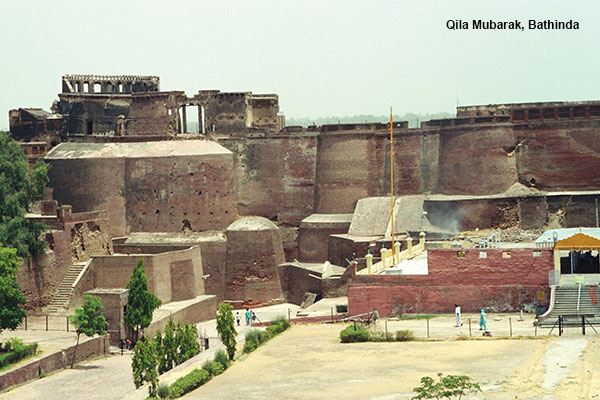 Bhatinda
Bhatinda
A famous railway junction town and the country’s largest cantonment, Bhatinda is named after an 1,800-year-old fort — Qila Mubarak — situated on a high mound of earth. The bricks used to build the fort go back to the historic Kushan period (30-375 CE). A gurudwara within the fort commemorates the visit of Guru Gobind Singh. The Guru Nanak thermal plant is also sited in Bhatinda and the foundation stone of an oil refinery was recently laid here. Moreover Pepsico, the giant multinational company processes horticultural products here for domestic and foreign markets.
Despite its small-town image, Bhatinda is an excellent base to visit several spiritual and scenic sites in its environs. One such is the town of Faridkot, named after the famous Sufi mystic Sheikh Baba Farid whose teaching is recounted in the Granth Sahib. Faridkot has several fine buildings, foremost among them being the former secretariat, which now houses the district court. Other interesting monuments in the town include the Guest House, Clock Tower, Darbar Ganj and the Stadium. The Faridkot Fort is famed for its mirror work and wall paintings.
About 30 km from Faridkot is the Jaito Gurudwara, the venue of a colourful annual fair where Punjabis from all parts of India congregate. The fair celebrates the victory of Akali volunteers over the British in 1923.
Fatehgarh Sahib. The Great Tirtha (pilgrimage centre) of the Sikh community, Fatehgarh Sahib (pop. 6 lakh) is situated 102 km north of Patiala. Its main gurudwara commemorates the martyrdom of Guru Gobind Singh’s two sons — Zorawar Singh and Fateh Singh — who refused to renounce their religious faith despite being tortured by the Suba of Sirhind. They were subsequently buried alive. In their memory, a grand two-day fair — Jor Mela — is held here every year in December.
Situated close by is Rauza Sharif, the serene mausoleum of Sheikh Ahmed Farooqi venerated as the ‘second Mecca’ by Sunni Muslims. Thousands of Muslims of the Naqshbandhi sect from Pakistan, Afghanistan and Indonesia visit the mausoleum annually in August. Within the premises are tombs and cenotaphs, including a stunningly crafted image of King Shah Zaman of Afghanistan.
Firozpur (aka Ferozepur). Situated smack on the Indo-Pak border, Firozpur is well connected with Amritsar (80 km), Ludhiana (150 km), Jalandhar (203 km), Chandigarh (180 km) and Delhi (380 km). There are several shrines, historic places and memorials in and around Firozpur. Most famous among them is the Shaheed Bhagat Singh Memorial where the legendary freedom fighters Bhagat Singh, Rajguru and Sukhdev were executed by the British government for revolting against their rule. Every year, on March 23, a fair attended by thousands of people is held here in memory of these martyrs.
The Anglo-Sikh Memorial installed in Firozpur in 1976 displays weaponry used by the Sikhs, portraits of important historical personalities and paintings of award-winning Sikh artists Jaswant Singh and Kirpal Singh depicting heroic battle scenes.
Accommodation. Hotel Mittal Guest House (Rs.1,500-3,000 per night), Hotel Anand Renaissance (Rs.3,000-3,200).
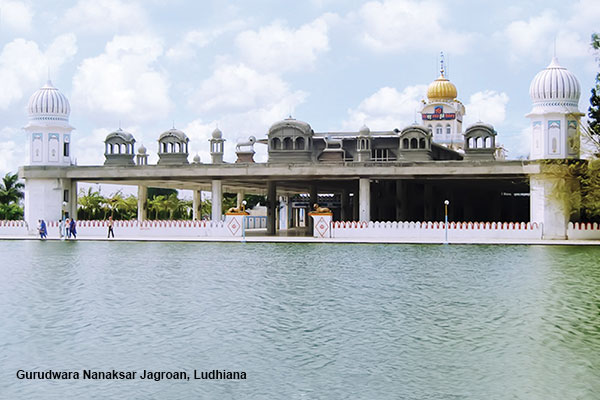 Ludhiana
Ludhiana
This city is the industrial metropolis of Punjab. World-class machine tools and motor parts, hosiery and woollen goods are manufactured here and exported around the world. Ludhiana (pop.1.6 million) is also famous for its high quality golden wheat which commands a premium in both domestic and overseas markets. The city has also emerged as an important centre of learning with the Christian Medical College, Ludhiana Engineering College and the Punjab Agricultural University (famous for sparking the green revolution in Punjab) located here.
Ludhiana is an excellent base for quick getaways to revered gurudwaras and culture-rich areas like Sarai, Doraha, a protected monument situated south of the city. The sarai contains a 168 sq. metre enclosure of battlement walls with octagonal bastions at each corner. The entrance arch of each gateway is framed with glazed tiles forming a pattern of stars and swastikas. Particularly noteworthy are the octagonal apertures in the ceilings for light and ventilation and a unique hammam system for heating water.
Accommodation: Radisson Blu (5,142 per night), Hyatt Regency (Rs.6,488), Imperial Executive (Rs.3,275), Park Plaza (Rs.4,956), Nirvana Hotels (Rs.2,881).
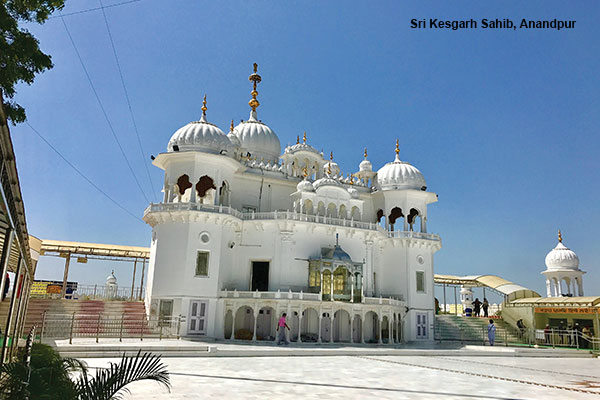
Anandpur
Anandpur Sahib aka City of Bliss is replete with religious history and traditions. Sited 85 km from Chandigarh, it is well connected by road and rail. The town, founded in 1665 by Guru Tegh Bahadur, the ninth Sikh guru, near the ruins of ancient Makhowal, achieved its greatest glory during Guru Gobind Singh’s rule of the khalsa as he spent nearly 25 years of his life here.
It was at Anandpur Sahib — on the occasion of Baisakhi in 1699 — that Guru Gobind Singh created the panj pyaras and thus laid the foundation of the fellowship of the khalsa or supreme religious council of the Sikh community. Multitudes of people congregate here every year in March to celebrate Hola Mohalla which is a national festival. The Hola Mohalla celebrations symbolise Guru Gobind Singh’s fight against the forces of tyranny. The festival concludes with a colourful procession accompanied by assorted musical instruments like nagaras, shehnais and dhols.
At Anandpur Sahib, devotees first pay obeisance at Sri Kesgarh Sahib which is one of the panj takhts of the Sikhs and the most attractive sites of Sikh architecture. It was here that the khalsa was created by Guru Gobind Singh when he asked five persons to come forward and lay down their lives for him in front of huge crowds.
To perpetuate the memory of 320 years of the khalsa, the Punjab government has resolved to create a Khalsa Heritage Complex at Anandpur Sahib to house a Sikh museum unparalleled in the world. It will employ state-of-the-art multimedia and hi-tech equipment to illuminate Anandpur Sahib while the museum will depict the saga of the struggle and bravery of the Sikh community. Currently, a daily son et lumiere show is held at Quila Anandgarh which highlights the history of the Sikh gurus.
Excursions. There are several excursion options ex Anandpur Sahib including the Naina Devi Temple (58 km), set amidst picturesque hills and visited by thousands of devotees from across India. The Bhakra Dam, the world’s highest concrete dam and a national showpiece, is a mere 35 km by road and attracts large crowds of domestic and foreign tourists.
Accommodation: Temple View Inn (Rs.1,069 per night), Hotel White City (Rs.1,245), Grand Hotel (Rs.1,504).
Sangrur Diwankhana. This splendid capital of the erstwhile Jind State is situated 80 km from Patiala. The most famous tourist attraction here is the Marble Baradri. sited in the middle of a clear water pool, it’s decorated with intricately carved marble slabs in the form of jaalis (perforated screens). The monument reflects ethereal vistas in the surrounding water on moonlit nights.
The scenic Banasar Gardens in Sangrur are a horticulturist’s delight. Diwankhana, the hall where the erstwhile rulers of Jind conducted their durbar (assemblies) boasts a museum with an impressive display of ancient weaponry, clothing, artefacts used by the former royals.
Close to Sangrur is Malerkotla, an ex-Afghan state of Punjab celebrated for its qawals and local handicrafts, badges, insignia, jutties (ethnic footwear) etc. The Idgah here, sited on a sprawling five-acre plot on the outskirts of the town is a striking monument reflecting a unique melange of architectural styles from different regions of the world.
Weather. Winters (November to February) can be very cold with temperatures plummeting to 1°C or less. Hence, it’s advisable to carry heavy woollens and a sturdy pair of walking shoes. Summers can be searing with the mercury shooting up to nearly 50°C in certain landlocked regions. The best time to visit and enjoy Punjab is between late February and April.
Also Read: Hampi – testimony to a golden age
























